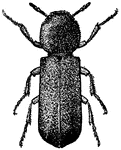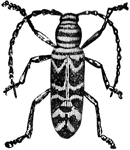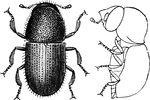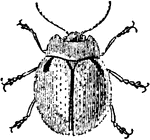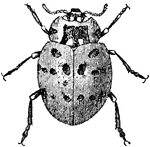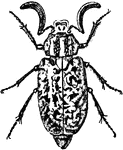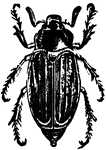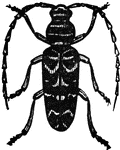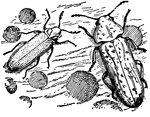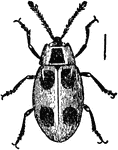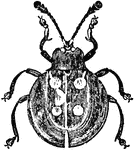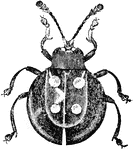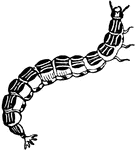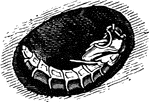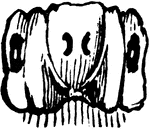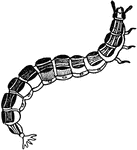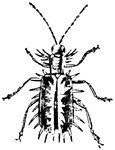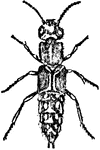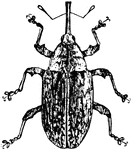This ClipArt gallery includes 561 illustrations of insects from the order Coleoptera, including beetles, weevils, borers, carabus, scarabs, and ladybugs (also known as ladybirds or lady beetles).
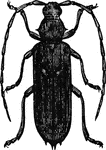
Banded Hickory Borer
Very variable in size and color, but usually a brownish gray and covered in shory whitish gray hairs.…
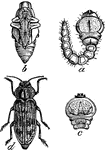
Flat Headed Apple Tree Borer
A long, depressed form borer. Usually brownish green, roughened by shallow pits of brighter metallic…

Tree Borer
The Hickory tree-borer is among many beetles whose larvae bore into trees, where they do great damage.…

Tree Borer
The Hickory tree-borer is among many beetles whose larvae bore into trees, where they do great damage.…
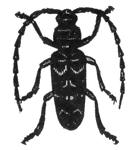
Tree Borer
The Hickory tree-borer is among many beetles whose larvae bore into trees, where they do great damage.

Brachelytra
"Readily distinguished from the other groups of beetles by having the elytra much shorter then the abdomen,…
Bruchus Pisi
Pictured are the beetle of the natural size (a), and enlarged (b), and a pea (c) in which the hole of…

Giant Buprestis
"The Giant Buprestis, B. gigantea of guiana, is two inches long, and its body is of a green…
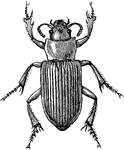
Caraboid Beetle
"Geopinus incrassatus. GEOPINUS. A genus of caraboid beetles, of the subfamily Harpalinae, having the…
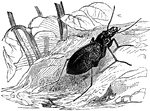
Blue Carabus
"The Blue Carabus, C. cyaneus, is an inch and a quarter long, the body oval, flat, and above…
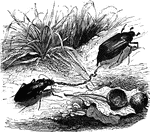
Golden Carabus and Cock-Chafer
"In illustration of the savageness of this race, the author of the "Jardin des Plantes" tells us of…
!["The Inquisitor Carabus, <em>C. inquisitor</em>, has the same form and manner as the [Sycophant Carabus]: the body is an inch long, and of a blackish-green color." — Goodrich, 1859](https://etc.usf.edu/clipart/14600/14649/inquiscarabs_14649_mth.gif)
Inquisitor Carabus
"The Inquisitor Carabus, C. inquisitor, has the same form and manner as the [Sycophant Carabus]:…

Cassida gibbosa
"The Cassida gibbosa of Brazil, three quarters of an inch long, is one of the larger species…
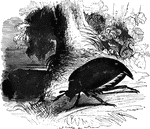
Cockchafer
"In the common European Cock-Chafer, Melolontha vulgaris, they are of considerable length,…
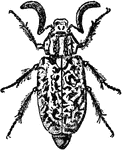
Cockchafer
The cockchafer (colloquially called may bug, billy witch, or spang beetle, particularly in East Anglia)…

Male and Female Cockchafer
Cockchafer, also known as may bugs, is the common name of melolontha vulgaris. These beetles are native…
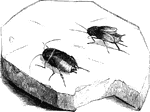
Common Cockroach
"Blattina includes the Cockroaches, the most noted species of which, the Black beetle or Common…

Larva of the Colorado Beetle
The larva of the colorado beetle is very unlike the adult insect. The larva is harmful to gardens.
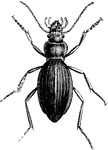
Common Ground Beetle
The common ground beetle feeds mostly on insects, though some of them are partly vegetarian.

Cryptocephalus
A small beetle, about a quarter of an inch long. Usually a brilliant golden green color.
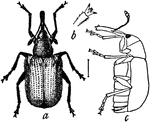
Rose Curculio
"Rose-curculio (Rhynchites bicolor). a, beetle; c, same in profile; b, claw." -Whitney, 1911

Devil's Coach Horse
The Devil's Coach Horse is also known as Rove Beetles. These beetles feed largely on decaying matter.
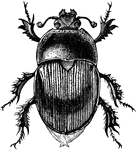
Drone Beetle
"Drone-beetle (Geotrypes splendidus). GEOTRYPES. A Fabrician genus of beetles typical of the family…
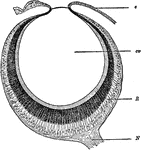
Eye of Waterbeetle
Section through the eye of a waterbeetle. Labels: l, chitinous lens; cv, transparent cells; pg, pigment…

Fire-fly
Illustration of a fire-fly commonly found in the West Indies. Its scientific name is Pyrophorus noctilucus.

Common Eastern Firefly
"Common Firefly (Photinus pyralis). a, larva; b, pupa in its earthen cell; c, beetle. d, e, f, leg,…

Glow Worms
The glow worm is from the species serricorn beetles. Segments of their bodies are luminous, hence glow…

Common Glowworm
The Common Glowworm (Lampyris noctiluca) is a species of beetle in the Lampyridae family of fireflies.

